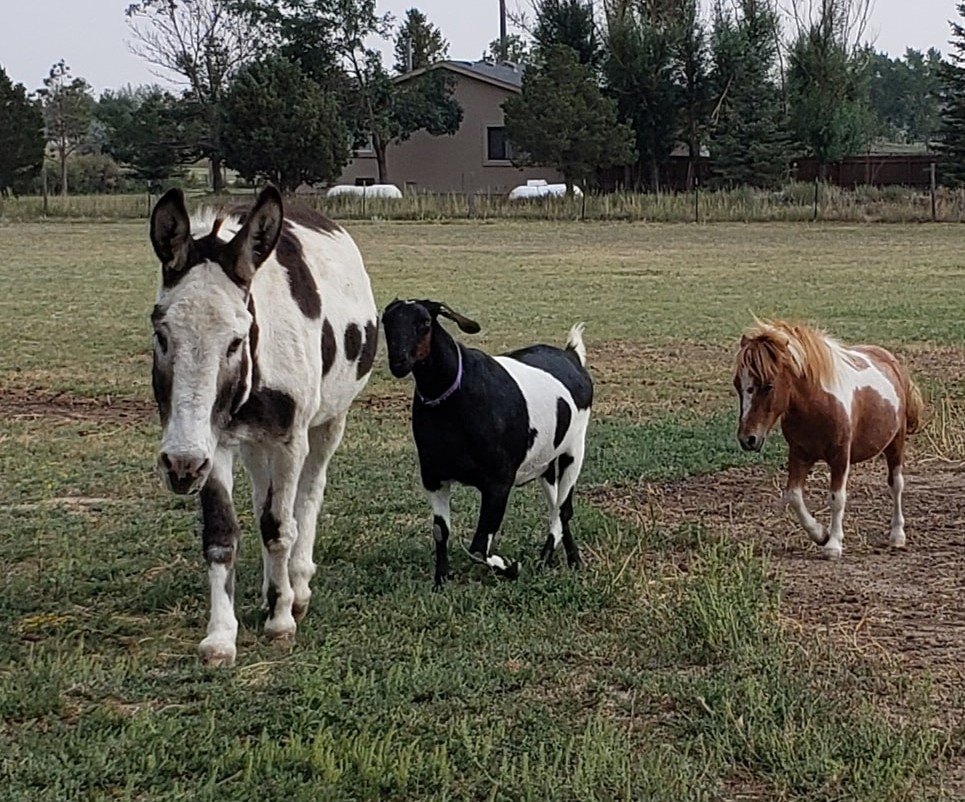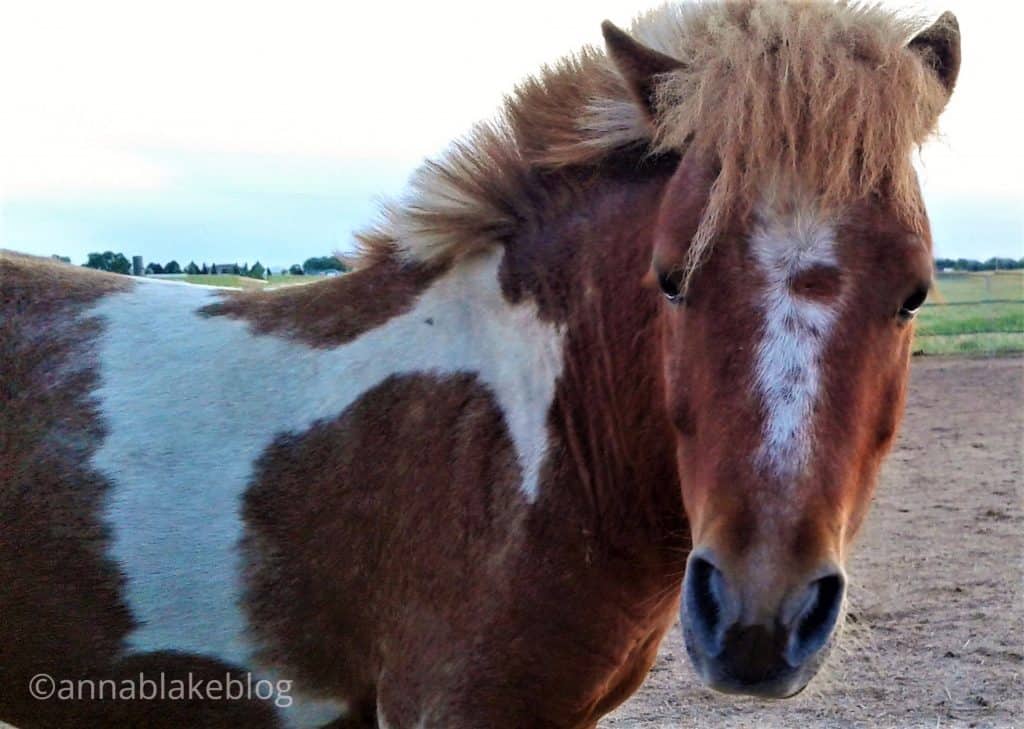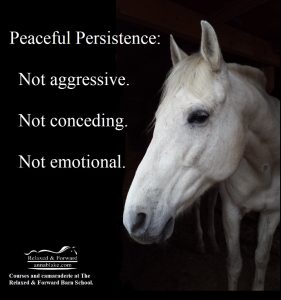
I have a herd of relatively normal retired horses. And then this gang of raconteurs, misanthropes, and dangerous characters, referred to as The Spots. If I’m feeling affectionate, they are The Deplorables because those who take such pride in breaking the rules deserve a term of endearment. Excuse my arrogance. I don’t even know the rules where they’re concerned.
I’m just home after being gone working a clinic. No one in the barn acted like they missed me, and my feelings weren’t hurt. If they were all heartbroken and desperate to see me, I’d think they hadn’t been fed enough.
Edgar Rice Burro lifted his noggin and hollered at me in his charming, gasping, farting, honking way. He heaves a bray when he even sees me in the window. He’s probably been calling me when I was gone, so this means I’m days late to come out and I’ll get a real long-ear-full. He’s the brains in the herd. With the agility of a jewel thief, he can open any gate. Think Cary Grant. And right now, he is running at me. I’m thrilled, not because he loves me.
He was hopping with three legs before I left. I hoped it was an abscess because that was the best lameness option, but it had been three weeks. Also, the third serious lameness in a month. I had soaked it twice a day and bandaged it. Donkeys are less tolerant of buckets than horses, and the soaking boots are huge. Then I remembered that I’d gotten a dry bag a few years ago in New Zealand. It was part of a gift bag from Equidays and I didn’t know what it was for the longest time. Well, just the size of a donkey leg. Keep everything, just in case.
Edgar hated the soaking and bandaging twice a day. I tried it pass it off as a spa treatment. He surrendered, hung his head low, and glowered at me. Finally, forty-eight hours before I was supposed to leave, the abscess started seeping. And he was back to wrestling Arthur before I left. Whew.
Arthur was my Grandfather Horse’s goat and has always had an unhealthy relationship with horses. I found him one night lying quietly under his tall friend’s hoof. Arthur’s leg was broken to bits, then reset twice, and is still a peg leg. Earlier this spring, he injured the front leg that he compensates with. The previous goat vet retired, so it was up to me. I wrapped it and miraculously, it healed. More than that, the bandage stayed on for over two weeks, which might be a world record. Please, hold your applause.
Arthur is eight now. Summer is hard and winter is worse. Arthritis has gotten him locked in The Spots pen. If I don’t scratch his nubbins, I get a butt in the butt. He starts every meal trying to knock Edgar off his feet. Arthur says most families are a little dysfunctional. It’s true. I had an uncle just like him.
Just home, I hurried to feel Edgar’s hoof for heat. Bhim walked right up and let me rub his neck. I suppressed a scream. It probably doesn’t sound like a big deal. Then he got a worried look on his face like he woke up with an empty bottle of Jack and a lampshade on his head. For the last ten years, he’s treated me like a cheap one-night stand. I could tell you his sad story, but Bhim thinks sympathy is for dolts. He’s right. Sympathy is worthless to a horse as frightened and angry as he was.
The first glimmer of Bhim softening was eighteen months ago when he showed me his first calming signal. The farrier was coming, and it usually took about forty-five minutes to halter him. Eventually, he would volunteer, but year after year, I had to prove myself every time to get it done. It’s like Edgar Rice Burro says, “The more impatient you are, the longer it takes.” That day Bhim did something I’d never seen. He licked and chewed. His muzzle had always been tight as a cross stitch. It felt like the dark clouds parted and sparkly light shone on him. Neither of us believed it.
I decided to try again, not that we hadn’t tried before. Bhim is the most complicated horse I’ve ever worked with. The least forgiving and the most distrustful. But calming signals change everything. I also decided to video each session with this reactive horse. Then, I let folks follow us and they were excited at first. Most have lost interest. Training is about the tortoise, not the hare.
May I brag? Most trainers don’t have the guts to take on a thirty-six-inch horse, much less let people watch. But I’m not really bragging. He’ll probably outlive me, and he won’t be safe if we can’t make peace.
Where Edgar and Arthur are concerned, I know our best days aren’t ahead of us. I don’t ask a thing of them. We’ll walk it out together. But maybe Bhim’s best days are finally here. Neither of us has quit. And now, eighteen months later, he offered me his neck. He also ground drives wearing a collar and pulling a singletree.
And I finally get to my point. My clients always ask me how long re-training will take. “When will my horse ever be able to …?” Like I have a math equation that works for all horses. Don’t use Bhim as a marker. He is special. Some of my clients are working with horses handled harshly in the past. Or they are learning new methods for a kinder path themselves. It never happens quickly enough. We squint for the finish line.
We wish we were at a different place with our horses. Which means we aren’t actually with our horses at all. We want to change them, but don’t acknowledge calming signals or mark small wins. We are so used to seeing before and after pictures that we forget the best part is in the middle. If Bhim and The Deplorables have taught me anything, it’s to accept them as they are. We train for life, but the journey begins and ends with acceptance. Impatience isn’t the problem.
I’ve been a self-employed artist since I was twenty-one. I’ve worked in a few different media, but horses will always be my favorite. Never forget training is literally an art, no less that painting or writing. Unexpected things come together in ways we don’t foresee if we stay the course. Take pride in stubbornness while giving up control. Cheer the perfect moments. Remember that horses live in their own time zone.
This Ursula Le Guin quote is as applicable to horse training as any other art form:
“If writing bores you, that is pretty fatal. If that is not the case, but you find that it is hard going and it just doesn’t flow, well, what did you expect? It is work; art is work.”
Some days Bhim is reluctant. Other days, I probably ask too much. We are a work in progress. He might be my last horse. But I might be his great masterpiece.

Read about our journey on this Blog or follow us at The Barn School.
Relaxed and Forward Training by Anna Blake is no longer on Facebook because of repeated hacking. If you or your horse appreciate my writing, please share, subscribe to this blog, or join us at The Barn School.
 The Barn School, is a social and educational site, with member sharing and our infamous Happy Hour. Anna teaches courses like Calming Signals and Affirmative Training. Everyone’s welcome.
The Barn School, is a social and educational site, with member sharing and our infamous Happy Hour. Anna teaches courses like Calming Signals and Affirmative Training. Everyone’s welcome.
Want more? Become a sustaining member, a “Barnie.” Subscribe to our online training group with affirmative demonstration videos, audio blogs, daily quotes, free participation in “group lessons”, and live chats with Anna. Become part of the most supportive group of like-minded horsepeople anywhere.
Visit annablake.com to find archived blogs, purchase signed books, schedule a live consultation, subscribe for email delivery of this blog, or ask a question about the art and science of working with horses.
Ride for a new brand, find our Relaxed and Forward swag at Zazzle.
Affirmative training is the fine art of saying yes.
…
I don’t know if this is significant, but your writing and training experiences make my day. I truly appreciate it and the fact that it is delivered to my inbox effortlessly is even better.
I admire your work.
I am in Argentina, and I have not found people working with a different approach other than “this is how it ‘s done, I know it all” Anyway, it’s probably me, I haven’t been out and about doing enough searching.
Thank you.
Thank you, Cecilia. It’s very significant to me. The little I know about horsemanship in your country is pretty different from mine. But also a long tradition there… we need to stick together and try to do better for horses. It’s good to hear from you.
Important information, beautifully written (as usual)
Thank you, Dee
You are the best!! I love the way you look at animals. You are always spot on!! I have had horse my entire life, I am 68, and can’t imagine life without them, they capture your heart and soul. Thank you for sharing your wonderful stories, definitely gives one “food for thought!”
Thanks Cynthia. Here’s to sticking it out.
Loved the Spots. They are a unique and rewarding group. Thanks for sharing.
Not sure how we all landed here, but here we are! Thanks, Nancy
Hi Anna After reading about your ‘ponies’, Bhim, Edgar & Arthur, I realize that my 2, Ozzie & Finn, are miracles! They are both so nice to be around, very trainable & easy-going. Bless you for being willing to put up with them!
Hooray for your ponies getting a good start. So often, it’s happened before we get them. Bhim isn’t normal, but he is an opportunity for me. Thanks Susan.
Congratulations to you and Bhim and Edgar-abscess wise and Arthur-pegleg wise.
I think the answer to the question – it takes as long as it takes.
In order for RE-training to be necessary – an animal either has been abused or hurt in some way. Proving that it wont happen anymore? If thats all an animal (or a child for that matter) has known – its a long haul and I think sometimes it just isnt possible.
Sounds like Bhim might see the light at the end of that tunnel! So maybe a win.
I agree, it’s a long recovery. And I’ve had plenty where it wasn’t possible. There were years that I thought it was more than Bhim could do, so I didn’t ask more then farrier and vet work. Thanks Maggie. As long as I can, I do.
Awesome read!!
Thanks, Karen
I love your artist metaphor, from one artist to another…seeing humans as the artists who must do the work of understanding horses as their medium before the horse can create a masterpiece of the artist describes the process so perfectly. Letting go of all the broad stroke agenda/control/goal brushes I was role modeled as a child and then again in my “upbringing” of my horse, showed me how quickly the light in a sentient being’s eyes goes from fear and resistance to minimal compliance. Once that mirror became too obvious, I was ready to learn how to use the finest nuanced/noticing/allowing brushes to create the trusting relationship. Some girls just need to learn it from a horse…
Such a great comment. It reminds me of the notice of detail so crucial… Thanks Michelle
Wait. Hold on. We all need to take a minute to appreciate your Olympic level skill. You bandaged a GOAT (sorry Arthur) and it stayed on for 2 weeks?!? That is some next level bandaging. *standing ovation*
Also “most trainers don’t have the guts to take on a 36” tall horse…”. Truer words were never spoken. Not a brag, but a fact!
Thank you, *holds hands up in humility for the cameras*, thank you, thank you… Jane, sometimes my amateur vet skills even surprise me. I can also perform a vaginal flush on a llama, but it rarely comes up in conversation.
I swear, if we lived closer, I’d have you over. He is the most interesting horse.
And I would love that! I’ll bring camp chairs and homemade salsa, guacamole and chips. Stories lonnnng into the evening!
Looking at the picture of The Spots, I smile, chuckle & feel love.
What a joy it was to read this update on the herd and a reminder just slow down and enjoy the hidden nuggets in my inbox.
Sounds like Bhim is getting more experienced at how good it can feel to be scratched.
Thank you Bhim & Anna for showing me another way, a quieter, slower way through Bhim’s diaries.
Thanks, Holly. Like This Spots would tolerate me any other way…
Happiness is an Anna Blake blog…I’m in awe!
Thanks, Lynell. So good to be home.
Awesome update on the gang.
“It takes as long as it takes” is so cheesy and still the matter-of-fact truth. I love its gift of presence.
It’s as trite, and true, as the worn and overused “Less is more.” Cindy, thanks. Presence is the sweetest place, even on bad days.
“How long does it take to train a horse”? I’m thinking it takes as long as you both shall live. Life changes us all. Changing herd mates, partners or friends, and changes in age, health, and climate name only a few. If each interaction with every horse, every animal, and every human were carried out with respect, patience, and without expectation; I imagine things would be more peaceful, and understanding would be the norm. It takes true tenacity to achieve the art of communication with horses (and all living things). One moment at a time, we build towards success. Thanks to your guidance, Anna.
Yes… train for life. Thanks Laurie.